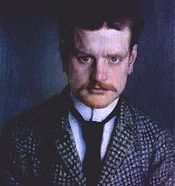Born in 1865, Jean Sibelius grew to be considered a national hero in his native Finland. A Romantic Nationalist, Sibelius even had his picture on the $100 Mark for a time.
Sibelius’s rise to fame came as Finland was fighting for independence against Lenin and the Soviet Union. “Finlandia,” one of Sibelius’s most famous works, was written during this period and at one point was considered the Finnish national anthem.
As a boy, Sibelius had dreams of becoming a famous virtuoso violinist. However, he started his training as a lawyer at the University of Helsinki. His love for music eventually got the best of him, and he transferred to what is now the Sibelius Academy of Music, which at the time was called the Helsinki School of Music.
Widely known as a symphonist, Sibelius wrote seven symphonies and had agreed to write an eighth, which was scheduled for a premiere but never came to fruition.
Sibelius’s Violin Concerto (the only concerto he wrote) is symphonic in scope and is marked by melancholy melodies and dark harmonies. Sibelius uses the violin as part of the texture while displaying the instrument’s virtuosic qualities and giving the orchestra equal importance.
Though Sibelius was himself a violinist, he composed only one violin concerto. This music did not come easily, perhaps because he was so close to the instrument.
The violin concerto was premiered in Helsinki in February 8th, 1904 and was considered a disaster. This was partially Sibelius’ fault as he didn’t finish the piece until the last minute and therefore didn’t give the soloist enough time to learn it.
After the first performance, Sibelius revised the work extensively to the version we know today. It was given a second “premeire” in Berlin, conducted by Richard Strauss, and was received very well. After this performance it was played a few more times, but slipped into obscurity until 1991 when the Sibelius estate allowed one performance and one recording to be published. Since that time it has become a mainstay in the violin repertoire.
By 1903, Sibelius had already composed his first two symphonies and a series of overtly nationalistic works: the Karelia Suite; the choral “Kullervo” symphony; the four Lemminkäinen legends; and the famous tone-poem Finlandia. All of these bore the hallmarks of late Romanticism; but his style was about to undergo a marked change.
By the time of the Third Symphony (1907), his music had become harder-edged, condensed, and rigorously organized. The Violin Concerto thus stands at a turning point in Sibelius’s output. Janus-like, it looks two ways at once: back towards the expressive romanticism of his earlier years, and forwards toward the concise, rugged, highly concentrated music of his future. Both of these elements can be heard in this work, which remains one of the pinnacles of the violin concerto repertoire.
Concerto in D Minor for Violin and Orchestra
Op. 47
Composed in 1905
By Jean Sibelius






